TFA POP 30.3051.01 Handleiding
TFA
Thermometer
POP 30.3051.01
Bekijk gratis de handleiding van TFA POP 30.3051.01 (6 pagina’s), behorend tot de categorie Thermometer. Deze gids werd als nuttig beoordeeld door 34 mensen en kreeg gemiddeld 4.6 sterren uit 17.5 reviews. Heb je een vraag over TFA POP 30.3051.01 of wil je andere gebruikers van dit product iets vragen? Stel een vraag
Pagina 1/6

Funkthermometer mit Uhr
Vielen Dank, dass Sie sich für dieses Produkt aus dem Hause
TFA entschieden haben.
1. Bevor Sie mit dem Gerät arbeiten
• Lesen Sie sich bitte die Bedienungsanleitung genau durch.
• Durch die Beachtung der Bedienungsanleitung vermeiden
Sie auch Beschädigungen des Gerätes und die Gefährdung
Ihrer gesetzlichen Mängelrechte durch Fehlgebrauch.
• Für Schäden, die aus Nichtbeachtung dieser Bedienungs-
anleitung verursacht werden, übernehmen wir keine Haf-
tung. Ebenso haften wir nicht für inkorrekte Messwerte und
Folgen, die sich aus solchen ergeben können.
• Beachten Sie besonders die Sicherheitshinweise!
• Bewahren Sie diese Bedienungsanleitung gut auf!
2. Zu Ihrer Sicherheit
• Verwenden Sie das Produkt nicht anders, als in dieser Anlei-
tung dargestellt wird.
• Das eigenmächtige Reparieren, Umbauen oder Verändern
des Gerätes ist nicht gestattet.
Vorsicht!
Verletzungsgefahr:
• Bewahren Sie die Batterien und die Geräte außerhalb der
Reichweite von Kindern auf.
• Batterien enthalten gesundheitsschädliche Säuren und kön-
nen bei Verschlucken lebensgefährlich sein. Wurde eine Bat-
terie verschluckt, kann dies innerhalb von 2 Stunden zu
schweren inneren Verätzungen und zum Tode führen. Wenn
Sie vermuten, eine Batterie könnte verschluckt oder ander-
weitig in den Körper gelangt sein, nehmen Sie sofort medi-
zinische Hilfe in Anspruch.
• Batterien nicht ins Feuer werfen, kurzschließen, auseinan-
dernehmen oder aufladen. Explosionsgefahr!
• Um ein Auslaufen der Batterien zu vermeiden, sollten
schwache Batterien möglichst schnell ausgetauscht werden.
Verwenden Sie nie gleichzeitig alte und neue Batterien oder
Batterien unterschiedlichen Typs.
• Beim Hantieren mit ausgelaufenen Batterien chemikalienbe-
ständige Schutzhandschuhe und Schutzbrille tragen!
Wichtige Hinweise
zur Produktsicherheit!
• Setzen Sie das Gerät keinen extremen Temperaturen, Vibra-
tionen und Erschütterungen aus.
• Vor Feuchtigkeit schützen.
• Der Außensender ist spritzwassergeschützt, aber nicht was-
serdicht. Suchen Sie einen niederschlagsgeschützten Platz
für den Sender aus.
3. Inbetriebnahme
Batterien einlegen
• Legen Sie die Geräte in einem Abstand von ca. 1,5 Metern
voneinander auf einen Tisch. Vermeiden Sie die Nähe zu
möglichen Störquellen (elektronische Geräte und Funkanla-
gen).
• Ziehen Sie die Schutzfolie vom Display des Außensenders
und der Basisstation.
• Öffnen Sie das Batteriefach des Außensenders, indem Sie
den Batteriefachdeckel nach unten schieben (siehe Markie-
rung) und den Deckel abheben.
• Legen Sie zwei neue Batterien 1,5 V AAA polrichtig ein.
• Schließen Sie das Batteriefach wieder.
• Öffnen Sie das Batteriefach der Basisstation und legen Sie
zwei neue Batterien 1,5 V AAA polrichtig ein.
• Alle Segmente werden kurz angezeigt.
• Schließen Sie das Batteriefach wieder.
4. Empfang der Außentemperatur
• Nach dem Einlegen der Batterien wird die Außentemperatur
an die Basisstation übertragen.
• Das Funksignal-Symbol blinkt. Die Basisstation versucht
nun, die Außentemperatur zu empfangen.
• Wird die Außentemperatur nicht empfangen, erscheint „- -.-
” auf dem Display. Prüfen Sie die Batterien und starten Sie
einen weiteren Versuch. Beseitigen Sie eventuelle Störquel-
len.
• Sie können die Initialisierung auch manuell starten. Halten
Sie die IN/OUT Taste auf der Vorderseite der Basisstation für
drei Sekunden gedrückt.
• Auf dem Display der Außentemperatur erscheint „--.-” und
das Funksignal-Symbol blinkt. Die Basisstation versucht
nun wieder die Außentemperatur zu empfangen.
5. Display
• Das obere Display zeigt Ihnen die Außentemperatur an (Vor-
einstellung).
• Das untere Display zeigt Ihnen die Innentemperatur (Vorein-
stellung) und die Uhrzeit an.
• Mit der IN/OUT Taste können Sie im Normalmodus zwischen
der Innen- oder Außentemperaturanzeige in Großformat
auswählen.
6. Einstellung der Uhrzeit
• Halten Sie die SET/°C/°F Taste auf der Rückseite gedrückt.
• 12 Hr blinkt im Display.
• Mit der MEM/+ Taste können Sie im Einstellmodus das 12-
oder 24-Stunden-Zeitsystem auswählen. Im 12-h-System
erscheint auf dem Display AM oder PM.
• Drücken Sie die SET/°C/°F Taste.
• Die Stundenanzeige fängt an zu blinken und Sie können mit
der MEM/+ Taste die Stunden einstellen.
• Drücken Sie die SET/°C/°F Taste noch einmal.
• Die Minutenanzeige fängt an zu blinken und Sie können mit
der MEM/+ Taste die Minuten einstellen.
• Bestätigen Sie die Eingabe mit der SET/°C/°F Taste.
• Die eingestellte Uhrzeit erscheint auf dem Display.
7. Höchst- und Tiefsttemperaturen
• Drücken Sie die MEM/+ Taste auf der Rückseite des Gerätes.
• MAX erscheint auf dem Display.
• Die höchste Innentemperatur und Außentemperatur seit der
letzten Rückstellung wird angezeigt.
• Drücken Sie die MEM/+ Taste noch einmal.
• MIN erscheint im Display.
• Die niedrigste Innentemperatur und Außentemperatur seit
der letzten Rückstellung wird angezeigt.
• Um wieder die Anzeige mit den aktuellen Temperaturwerten
zu erhalten, betätigen Sie nochmals die MEM/+ Taste.
8. Speichern und Löschen der maximalen und minimalen
Werte
• Sobald die Basisstation und der Außensender aktiv sind,
werden die maximalen und minimalen Temperaturwerte für
Innen und Außen gespeichert.
• Halten Sie die MEM/+ Taste gedrückt, während auf dem Dis-
play die maximalen oder minimalen Temperaturen erschei-
nen, werden die jeweiligen Werte auf die momentane Tem-
peratur zurückgestellt.
9. Temperaturanzeige
• Drücken Sie die SET/°C/°F Taste im Normalmodus und Sie
können zwischen Celsius (°C) oder Fahrenheit (°F) als Tem-
peraturanzeige auswählen.
10.
Aufstellen und Befestigen der Basisstation und des Senders
• Mit dem ausklappbaren Ständer auf der Rückseite kann die
Basisstation aufgestellt werden. Vermeiden Sie die Nähe zu
anderen elektrischen Geräten (Fernseher, Computer, Funkte-
lefone) und massiven Metallgegenständen.
• Mit dem ausklappbaren Ständer auf der Rückseite kann der
Außensender aufgestellt werden oder mit der Aufhängeöse an
der Wand befestigt werden. Suchen Sie sich einen schattigen,
niederschlagsgeschützten Platz für den Sender aus. (Direkte
Sonneneinstrahlung verfälscht die Messwerte und ständige
Nässe belastet die elektronischen Bauteile unnötig).
• Prüfen Sie, ob eine Übertragung der Messwerte vom Sender
am gewünschten Aufstellort zur Basisstation stattfindet
(Reichweite Freifeld ca. 50 Meter), bei massiven Wänden,
insbesondere mit Metallteilen kann sich die Sendereichweite
erheblich reduzieren.
• Suchen Sie sich gegebenenfalls einen neuen Aufstellort für
Sender und/oder Empfänger.
11. Pflege und Wartung
• Reinigen Sie das Gerät mit einem weichen, leicht feuchten
Tuch. Keine Scheuer- oder Lösungsmittel verwenden!
• Entfernen Sie die Batterien, wenn Sie das Gerät längere Zeit
nicht verwenden.
• Bewahren Sie Ihr Gerät an einem trockenen Platz auf.
11.1 Batteriewechsel
• Sobald das Batteriesymbol in der Displayzeile der Außen-
temperatur erscheint, wechseln Sie bitte die Batterien im
Außensender.
• Sobald das Batteriesymbol in der Displayzeile der Innentem-
peratur erscheint, wechseln Sie bitte die Batterien in der
Basisstation.
•Achtung:
Bei einem Batteriewechsel muss der Kontakt zwischen
Außensender und Basisstation wieder hergestellt werden –
also Batterien immer in beide Geräte neu einlegen oder manu-
elle Sendersuche starten.
12. Fehlerbeseitigung
Problem Lösung
Keine Anzeige auf
➜
Batterien polrichtig einlegen
der Basisstation
➜
Batterien wechseln
Kein Senderempfang
➜
Batterien des Außensenders
Anzeige „---” prüfen (keine Akkus ver-
wenden!)
➜
Neuinbetriebnahme von
Außensender und Basis-
station gemäß Anleitung
➜
Manuelle Sendersuche
starten: IN/OUT Taste auf
der Basisstation gedrückt
halten.
➜
Anderen Aufstellort für
Außensender und/oder
Basisstation wählen
➜
Abstand zwischen Außen-
sender und Basisstation
verringern
➜
Beseitigen der Störquellen
Unkorrekte Anzeige
➜
Batterien wechseln
13. Entsorgung
Batterien und Akkus dürfen keinesfalls in den
Hausmüll!
Als Verbraucher sind Sie gesetzlich verpflichtet,
gebrauchte Batterien und Akkus zur umweltge-
rechten Entsorgung beim Handel oder entspre-
chenden Sammelstellen gemäß nationalen oder
lokalen Bestimmungen abzugeben.
Die Bezeichnungen für enthaltene Schwermetalle
sind: Cd=Cadmium, Hg=Quecksilber, Pb=Blei
Dieses Gerät ist entsprechend der EU-Richtlinie
über die Entsorgung von Elektro- und Elektro-
nik-Altgeräten (WEEE) gekennzeichnet.
Dieses Produkt darf nicht mit dem Hausmüll
entsorgt werden. Der Nutzer ist verpflichtet, das
Altgerät zur umweltgerechten Entsorgung bei
einer ausgewiesenen Annahmestelle für die Ent-
sorgung von Elektro- und Elektronikgeräten
abzugeben.
14. Technische Daten
Basisstation
Messbereich 0 °C…+50 °C
Innentemperatur: (+32 °F …+122 °F)
Anzeige LL.L /HH.H Temperatur außerhalb des
Messbereichs
Spannungsversorgung: 2 x 1,5 V AAA
(Batterien nicht inklusive)
Verwenden Sie Alkaline Batterien
Größe: 60 x 23 (50) x 90 mm
Gewicht: 57 g (nur das Gerät)
Außensender
Messbereich -20 °C… +60 °C
Außentemperatur: (-4 °F …+140 °F)
Reichweite: ca. 50 m (Freifeld)
Übertragungsfrequenz: 433 MHz
Maximale
Sendeleistung: < 10mW
Übertragungszeit: 60 Sekunden
Spannungsversorgung: 2 x 1,5 V AAA
(Batterien nicht inklusive)
Verwenden Sie Alkaline Batterien
Größe: 56 x 25 (55) x 90 mm
Gewicht: 53 g (nur das Gerät)
Diese Anleitung oder Auszüge daraus dürfen nur mit Zustimmung von TFA
Dostmann veröffentlicht werden. Die technischen Daten entsprechen dem
Stand bei Drucklegung und können ohne vorherige Benachrichtigung
geändert werden.
Die neuesten technischen Daten und Informationen zu Ihrem Produkt
finden Sie auf unserer Homepage unter Eingabe der Artikel-Nummer in
das Suchfeld.
EU-KONFORMITÄTSERKLÄRUNG
Hiermit erklärt TFA Dostmann, dass der Funkanlagentyp 30.3051 der
Richtlinie 2014/53/EU entspricht. Der vollständige Text der EU-Konfor-
mitätserklärung ist unter der folgenden Internetadresse verfügbar:
www.tfa-dostmann.de/service/downloads/ce
www.tfa-dostmann.de
E-Mail: info@tfa-dostmann.de
TFA Dostmann GmbH & Co.KG
Zum Ottersberg 12, D-97877 Wertheim, Deutschland 12/20
Bedienungsanleitung
Kat. Nr. 30.3051
Bedienungsanleitung
Kat. Nr. 30.3051
Bedienungsanleitung
Kat. Nr. 30.3051
TFA_No. 30.3051_Anl_D_GB_12_20 27.12.2020 16:20 Uhr Seite 1

Wireless thermometer with clock
Thank you for choosing this instrument from TFA.
1. Before you start using it
• Please make sure to read the instruction manual carefully.
• Following and respecting the instructions in your manual
will prevent damage to your instrument and loss of your
statutory rights arising from defects due to incorrect use.
• We shall not be liable for any damage occurring as a result
of not following these instructions. Likewise, we take no
responsibility for any incorrect readings and for any conse-
quences which may result from them.
• Please take particular note of the safety advice!
• Please keep this instruction manual for future reference.
2. For your safety
• This product should only be used as described within these
instructions.
• Unauthorised repairs, modifications or changes to the prod-
uct are prohibited.
Caution!
Risk of injury:
• Keep these devices and the batteries out of reach of chil-
dren.
• Batteries contain harmful acids and may be hazardous if
swallowed. If a battery is swallowed, this can lead to serious
internal burns and death within two hours. If you suspect a
battery could have been swallowed or otherwise caught in
the body, seek medical help immediately.
• Batteries must not be thrown into a fire, short-circuited,
taken apart or recharged. Risk of explosion!
• Low batteries should be changed as soon as possible to
prevent damage caused by leaking. Never use a combination
of old and new batteries together, nor batteries of different
types.
• Wear chemical-resistant protective gloves and safety glass-
es when handling leaking batteries.
Important information
on product safety!
• Do not place your product near extreme temperatures,
vibrations or shocks.
• Protect it from moisture.
• The instrument is protected against splash water, but is not
watertight. Choose a shady and dry position for the trans-
mitter.
3. Getting started
Insert batteries
• Place both instruments on a desk with a distance of approx-
imately 1.5 meter. Check that no other electronic devices are
close.
• Pull off the protection foil from the display of the transmitter
and the base station.
• Open the battery compartment of the transmitter by pulling
the battery compartment cover downwards (see marking)
and lift up the cover.
• Insert two new batteries 1,5 V AAA. Ensure battery polarities
are correct.
• Close the battery compartment again.
• Open the battery compartment of the base station and insert
two new batteries 1,5 V AAA, ensure battery polarities are
correct.
• All LCD segments will light up for a short moment.
• Close the battery compartment again.
4. Reception of outdoor temperature
• After the batteries are inserted the outdoor temperature will
automatically be transmitted to the base station.
• The reception signal symbol flashes. The base station will
scan the outdoor temperature.
• If the reception of the outdoor temperature fails, “--.-”
appears on the display. Check the batteries and try it again.
Check if there is any source of interference.
• You can start the initialization manually. Press and hold IN/
OUT button on the front of the base station for 3 seconds.
• “--.-” appears and the reception signal symbol flashes on the
display. The base station will scan the outdoor temperature
again.
5. Display
• The upper display shows the outdoor temperature (default).
• The lower display shows the indoor temperature (default)
and the time.
• Using the IN/OUT button, you can choose between the
large-scale display of indoor temperature or outdoor tem-
perature in normal mode.
6. Setting of the clock
• Press and hold SET/°C/°F button at the backside of the base
station.
• 12 Hr flashes on the display.
• Press MEM/+ button in normal mode to choose 12 HR or
24 HR system. In 12 HR system AM or PM appears on the
display.
• Press the SET/°C/°F button.
• The hour digit is flashing. Press MEM/+ button to adjust
hours.
• Press the SET/°C/°F button again.
• The minute digit is flashing. Press MEM/+ button to adjust
minutes.
• Confirm the setting with the button SET/°C/°F.
• The set time appears on the display
7. Maximum and minimum temperatures
• Press the MEM/+ button at the backside of the base station.
• MAX appears on the display.
• The highest indoor temperature and outdoor temperature
are displayed since the last reset.
• Press the MEM/+ button again.
• MIN appears on the display.
• The lowest indoor temperature and outdoor temperature are
displayed since the last reset.
• To go back to the present temperature display, press the
MEM/+ button once more.
8. Store and reset of the maximum and minimum values
• As soon as the base station and the outdoor transmitter are
active the maximum and minimum values for indoor and
outdoor will be stored.
• Press and hold the MEM/+ button while the values are dis-
played to reset the maximum and minimum temperature to
the present temperature.
9. Temperature display
• Press SET/°C/°F button to change between °C (Celsius) or
°F (Fahrenheit) as temperature unit.
10. Positioning and fixing of the base station and the trans-
mitter
• With the foldable leg at the back of the unit, the base station
can be placed onto any flat surface. Avoid the vicinity of any
interfering field like computer monitors or TV sets and solid
metal objects.
• With the foldable leg at the back of the transmitter it can be
placed onto any flat surface or wall mounted at the respec-
tive location by the hanging hole at the back of the unit.
Choose a shady and dry position for the transmitter. (Direct
sunshine falsifies the measurement and continuous humidi-
ty strains the electronic components needlessly).
• Check the transmission of the signal from the outdoor trans-
mitter to the base station (transmission range 50 m free
field). Within ferro-concrete rooms (basements, superstruc-
tures), the received signal is naturally weakened.
• If necessary choose another position for the outdoor trans-
mitter and/or base station.
11. Care and maintenance
• Clean your instrument with a soft damp cloth. Do not use
solvents or scouring agents.
• Remove the batteries if you do not use the product for a
lengthy period.
• Keep the instrument in a dry place.
11.1 Battery replacement
• When the battery symbol appears on the display of the out-
door temperature, replace the batteries in the transmitter.
• When the battery symbol appears on the display of the
indoor temperature, replace the batteries in the base station.
•Please note:
When the batteries are changed, the contact between trans-
mitter and base station must be restored – so always insert
new batteries into both units or start a manual transmitter
search.
12. Troubleshooting
Problems Solution
No indication
➜
Observe correct polarity
on the base station when inserting the batteries
➜
Change the batteries
No transmitter
➜
Check batteries of external
reception transmitter (do not use
Display “---” rechargeable batteries!)
➜
Restart the transmitter and
the base station as per the
manual
➜
Start manual search for the
transmitter: Press and hold
the IN/OUT button on the
base station
➜
Choose another place for
the transmitter and/or the
base station
➜
Reduce the distance
between the transmitter
and the base station
➜
Check if there is any source
of interference
Incorrect indication
➜
Change the batteries
13. Waste disposal
Never dispose of empty batteries and recharge-
able batteries in household waste. As a con-
sumer, you are legally required to take them to
your retail store or to an appropriate collection
site depending on national or local regulations
in order to protect the environment.
The symbols for the heavy metals contained are:
Cd=cadmium, Hg=mercury, Pb=lead
This instrument is labelled in accordance with
the EU Waste Electrical and Electronic Equip-
ment Directive (WEEE).
Please do not dispose of this instrument in
household waste. The user is obligated to take
end-of-life devices to a designated collection
point for the disposal of electrical and electronic
equipment, in order to ensure environmentally-
compatible disposal.
14. Specifications
Base station
Measuring range 0 °C…+50 °C
Indoor temperature: (+32 °F …+122 °F)
Indication LL.L / HH.H: Temperature is outside
measuring range
Power consumption: 2 x 1,5 V AAA
(batteries not included)
Use alkaline batteries
Dimensions: 60 x 23 (50) x 90 mm
Weight: 57 g (instrument only)
Outdoor transmitter
Measuring range -20 °C… +60 °C
Outdoor temperature: (-4 °F …+140 °F)
Range: max. 50 m (free field)
Transmission frequency: 433 MHz
Maximum
radio-frequency power: < 10mW
Transmission time: 60 seconds
Power consumption: 2 x 1,5 V AAA
(batteries not included)
Use alkaline batteries
Dimensions: 56 x 25 (55) x 90 mm
Weight: 53 g (instrument only)
No part of this manual may be reproduced without written consent of TFA
Dostmann. The technical data are correct at the time of going to print and
may change without prior notice.
The latest technical data and information about this product can be found
in our homepage by simply entering the product number in the search
box.
EU DECLARATION OF CONFORMITY
Hereby, TFA Dostmann declares that the radio equipment type 30.3051 is
in compliance with Directive 2014/53/EU. The full text of the EU declara-
tion of conformity is available at the following Internet address:
www.tfa-dostmann.de/service/downloads/ce
www.tfa-dostmann.de
E-Mail: info@tfa-dostmann.de
TFA Dostmann GmbH & Co.KG
Zum Ottersberg 12, D-97877 Wertheim, Germany 12/20
Instruction manual
Cat.-No. 30.3051
Instruction manual
Cat.-No. 30.3051
Instruction manual
Cat.-No. 30.3051
Instruction manuals
www.tfa-dostmann.de/en/service/downloads/instruction-manuals
TFA_No. 30.3051_Anl_D_GB_12_20 27.12.2020 16:20 Uhr Seite 2

Thermomètre radio-piloté avec horloge
Nous vous remercions d'avoir choisi l'appareil de la Société
TFA.
1. Avant d'utiliser l'appareil
• Lisez attentivement le mode d’emploi.
• En respectant ce mode d'emploi, vous éviterez d'endom-
mager votre appareil et de perdre vos droits résultant d'un
défaut pour cause d'utilisation non-conforme.
• Nous n'assumons aucune responsabilité pour des domma-
ges qui auraient été causés par le non-respect du présent
mode d'emploi.
• De même, nous n’assumons aucune responsabilité pour
des relevés incorrects et les conséquences qu’ils pour-
raient engendrer.
• Suivez bien toutes les consignes de sécurité !
• Conservez soigneusement le mode d'emploi !
2. Pour votre sécurité
• Ne l'utilisez jamais à d'autres fins que celles décrites dans le
présent mode d'emploi.
• Vous ne devez en aucun cas réparer, démonter ou modifier
l'appareil par vous-même.
Attention !
Danger de blessure :
• Gardez vos appareils et les piles hors de la portée des
enfants.
• Les piles contiennent des acides nocifs pour la santé et peu-
vent être mortelles dans le cas d’une ingestion. Si une pile a
été avalée, elle peut entraîner des brûlures internes graves
ainsi que la mort dans l’espace de 2 heures. Si vous crai-
gnez qu’une pile ait pu être avalée ou ingérée d’une autre
manière, quelle qu’elle soit, contactez immédiatement un
médecin d’urgence.
• Ne jetez jamais de piles dans le feu, ne les court-circuitez
pas, ne les démontez pas et ne les rechargez pas. Risque
d'explosion !
• Une pile faible doit être remplacée le plus rapidement possi-
ble afin d'éviter toute fuite. N'utilisez jamais simultanément
de piles anciennes avec des piles neuves ou des piles de
types différents.
• Pour manipuler des piles qui ont coulé, utilisez des gants de
protection chimique spécialement adaptés et portez des
lunettes de protection !
Conseils importants
de sécurité du produit !
• Évitez d’exposer l’appareil à des températures extrêmes, à
des vibrations ou à des chocs.
• Protégez-le contre l'humidité.
• L’émetteur extérieur est résistant aux éclaboussures d'eau
mais il n'est pas étanche. Choisissez un emplacement à
l'ombre et protégé de la pluie pour votre émetteur.
3. Mise en service - Insertion des piles
• Déposez les appareils sur une table à une distance d'environ
1,5 mètre l'un de l'autre. Évitez la proximité de sources de
parasitage (appareils électroniques ou appareils radio).
• Enlevez le film de protection de l’écran de l’émetteur et de la
station de base.
• Ouvrez le compartiment à pile de l’émetteur et poussez le
couvercle du compartiment de la pile vers le bas (voir le
marquage).
• Insérez deux piles neuves 1,5 V AAA, contrôlez la bonne
polarité des piles.
• Refermez le compartiment à pile.
• Ouvrez le compartiment à pile de la station de base et insé-
rez deux nouvelle piles 1,5 V AAA, contrôlez la bonne polari-
té des piles.
• Tous les segments LCD s'allument.
• Refermez le compartiment à pile.
4. Réception de la température extérieure
• Après l'insertion des piles, la température extérieure est
transférée de l'émetteur à la station de base.
• Le symbole de réception clignote. La station de base cher-
che la température extérieure.
• Si la température extérieure ne sont pas reçues, «--.-» appa-
raît sur l'écran. Contrôlez les piles et effectuez une nouvelle
tentative. Éliminez les éventuelles sources de parasitage.
•
Vous pouvez activer manuellement la réception. Appuyez sur la
touche IN/OUT sur la face de la station de base pendant trois
secondes. «--.-» apparaît et le symbole de réception commence
à clignoter sur l'écran.
• La station de base cherche à nouveau la température exté-
rieure.
5. Écran
• L’affichage supérieur vous indique la température extérieure
(par défault).
• L’affichage inférieur vous indique la température ambiante
(par défault) et l`heure.
• Avec la touche IN/OUT, vous pouvez, en mode normal,
sélectionner l'affichage de la température extérieure ou
ambiante en grand format.
6. Réglage de l'heure
• Maintenez la touche SET/°C/°F appuyée au verso de la sta-
tion de base.
• 12 Hr apparaît à l’écran.
• Vous pouvez ajuster le système horaire de 12 heures ou de
24 heures à l'aide de la touche SET/°C/°F en mode normal.
En système horaire de 12 heures AM ou PM apparaît sur
l'écran.
• Appuyez sur la touche SET/°C/°F.
• L’indicateur de l’heure commence à clignoter. Régler l’heure
à l'aide de la touche MEM/+.
• Appuyez encore sur la touche SET/°C/°F.
• L'affichage des minutes commence à clignoter. Régler les
minutes avec la touche MEM/+.
• Validez au moyen de la touche SET/°C/°F.
• L'heure réglée s'affiche sur l'écran.
7. Températures maximales et minimales
• Appuyez sur la touche MEM/+ au verso de la station de
base.
• MAX apparaît de l'écran.
•
La température ambiante et extérieure maximale depuis la der-
nière réactualisation apparaissent sur l’écran.
• Appuyez encore une fois la touche MEM/+.
• MIN apparaît de l'écran.
•
La température ambiante et extérieure minimale depuis la der-
nière réactualisation apparaissent sur l’écran.
• Appuyez encore sur la touche MEM/+ les valeurs actuelles
apparaissent sur l'écran.
8. Mémoriser et effacer les valeurs maximales et minimales
• Une fois que la station de base et l'émetteur sont actifs, les
valeurs maximales et minimales intérieures et extérieures
sont mises en mémoire.
• Pour effacer la mémoire, appuyez sur la touche MEM/+ les
valeurs maximales ou minimales sont affichées et celles-ci
disparaitront et remises aux valeurs du site en cours.
9. Affichage de la température
• En appuyant sur la touche SET/°C/°F, vous pouvez alors
sélectionner la température en Celsius (°C) ou Fahrenheit
(°F).
10. Mise en place et fixation de la station de base et de
l’émetteur
• À l'aide du pied au dos de votre appareil, la station de base
peut être mise en place sur une surface plate. Évitez une mise
en place à proximité d'autres appareils électriques (téléviseur,
ordinateur, téléphone sans fil) ou d'objets métalliques.
• À l'aide du pied au dos de votre appareil, l'émetteur peut
être mise en place sur un meuble ou encore être accrochée
au mur à l'aide de l'œillet de suspension. Choisissez un
emplacement à l'ombre et protégé de la pluie pour votre
émetteur. (évitez l'ensoleillement directe il peut fausser la
mesure et une humidité continue endommage les compo-
sants électroniques inutilement).
• Vérifiez que les valeurs de mesure entre l'émetteur et la sta-
tion de base (portée avec champ libre d'environ 50 mètres)
sont bien transmises de l'endroit choisi. En cas de murs
massifs, en particulier comportant des parties métalliques la
portée d'émission peut se trouver réduite considérablement.
• Si nécessaire cherchez de nouveaux emplacements pour
l'émetteur et/ou la station de base.
11. Entretien et maintenance
• Pour le nettoyage de votre appareil utilisez un chiffon doux
et humide. N’utilisez pas de solvant ou agent d'abrasif !
• Enlevez les piles, si vous n'utilisez pas votre appareil pen-
dant une durée prolongée.
• Conservez votre appareil dans un endroit sec.
11.1 Remplacement des piles
• Lorsque le symbole de pile apparaît sur l'écran de la tempé-
rature extérieure, changez les piles de l’émetteur.
• Lorsque le symbole de pile apparaît sur l'écran de la tempé-
rature intérieure, changez les piles de la station de base.
•Attention : Il faut rétablir le contact entre l'émetteur et le
récepteur après le remplacement des piles - Il faut donc tou-
jours remplacer les piles dans les deux appareils ou bien
lancer la recherche manuellement.
12. Dépannage
Problème Solution
Aucun affichage
➜
Contrôlez la bonne polarité
de la station de base des piles
➜
Changez les piles
Pas de réception de
➜
Vérifiez les piles de l'émet-
l'émetteur teur extérieur (n'utilisez pas
Affichage « --- » d'accus)
➜
Remettez l'émetteur et la
station de base en service,
conformément aux instruc-
tions
➜
Recherche manuelle de
l'émetteur : Maintenez la
touche IN/OUT appuyée
➜
Sélectionnez une autres
position pour l'émetteur et/
ou de la station de base
➜
Modifiez l'écart entre
l'émetteur extérieur et la
station de base
➜
Éliminez les éventuelles
sources de parasitage
Indication incorrecte
➜
Changez les piles
13. Traitement des déchets
Les piles et accus usagés ne peuvent en aucun
cas être jetés dans les ordures ménagères !
En tant qu'utilisateur, vous avez l'obligation
légale de rapporter les piles et accus usagés à
votre revendeur ou de les déposez dans une
déchetterie proche de votre domicile conformé-
ment à la réglementation nationale et locale.
Les métaux lourds sont désignés comme
suit :
Cd = cadmium, Hg = mercure, Pb = plomb
Cet appareil est conforme aux normes de l'UE
relatives au traitement des déchets électriques
et électroniques (WEEE).
L'appareil usagé ne doit pas être jeté dans les
ordures ménagères. L’utilisateur s’engage, pour
le respect de l’environnement, à déposer l’appa-
reil usagé dans un centre de traitement agréé
pour les déchets électriques et électroniques.
14. Caractéristiques techniques
Station de base
Plage de mesure 0 °C…+50 °C
Température ambiante : (+32 °F …+122 °F)
Affichage LL.L / HH.H : Hors de portée la gamme de
mesure
Alimentation : 2 x 1,5 V AAA
(piles non incluses)
Utilisez de piles alcalines
Mesure de boîtier : 60 x 23 (50) x 90 mm
Poids : 57 g (appareil seulement)
Émetteur extérieur
Plage de mesure -20 °C… +60 °C
Température extérieure : (-4 °F …+140 °F)
Rayon d’action : env. 50 mètres (champ libre)
Fréquence de
transmission : 433 MHz
Puissance de radio-
fréquence maximale
transmise : < 10mW
Le temps de
transmission : 60 secondes
Alimentation : 2 x 1,5 V AAA
(piles non incluses)
Utilisez de piles alcalines
Mesure de boîtier : 56 x 25 (55) x 90 mm
Poids : 53 g (appareil seulement)
La reproduction, même partielle du présent mode d'emploi est stricte-
ment interdite sans l'accord explicite de TFA Dostmann. Les spécifications
techniques de ce produit ont été actualisées au moment de l'impression
et peuvent être modifiées, sans avis préalable. Les dernières données
techniques et des informations concernant votre produit peuvent être
trouvées en entrant le numéro de l'article sur notre site.
DÉCLARATION UE DE CONFORMITÉ
Le soussigné, TFA Dostmann, déclare que l'équipement radioélectrique du
type 30.3051 est conforme à la directive 2014/53/UE. Le texte complet de la
déclaration UE de conformité est disponible à l'adresse Internet suivante :
www.tfa-dostmann.de/service/downloads/ce
www.tfa-dostmann.de
E-Mail : info@tfa-dostmann.de
TFA Dostmann GmbH & Co.KG
Zum Ottersberg 12, D-97877 Wertheim, Allemagne 12/20
Mode d'emploi
Réf. 30.3051
Mode d'emploi
Réf. 30.3051
Mode d'emploi
Réf. 30.3051
TFA_No. 30.3051_Anl_F_I_12_20 27.12.2020 16:19 Uhr Seite 1
Product specificaties
| Merk: | TFA |
| Categorie: | Thermometer |
| Model: | POP 30.3051.01 |
Heb je hulp nodig?
Als je hulp nodig hebt met TFA POP 30.3051.01 stel dan hieronder een vraag en andere gebruikers zullen je antwoorden
Handleiding Thermometer TFA
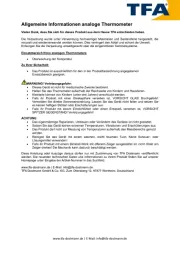
17 April 2025
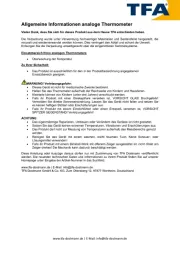
17 April 2025
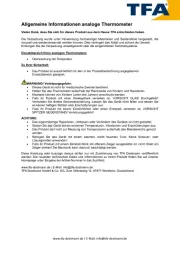
17 April 2025
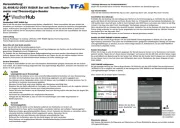
17 April 2025

29 Maart 2025
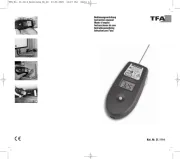
4 Maart 2025

4 Maart 2025

4 Maart 2025
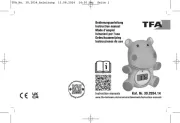
5 Februari 2025

21 December 2024
Handleiding Thermometer
- Grado
- Knikker
- Hartig And Helling
- Cotech
- Welby
- Anycare
- Kuchenprofi
- Medel
- Turbotech
- Omega
- Cuisinart
- WBTT
- Global Tronics
- Sanitas
- Mabis
Nieuwste handleidingen voor Thermometer
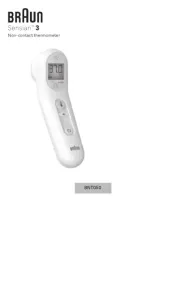
28 Juli 2025
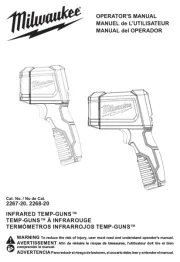
21 Juli 2025
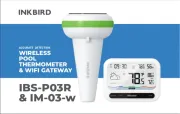
15 Juli 2025
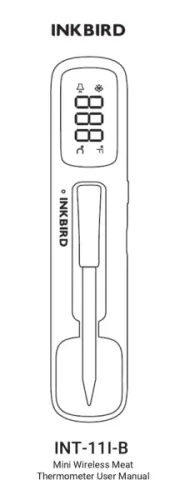
14 Juli 2025
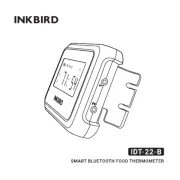
14 Juli 2025
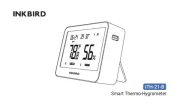
14 Juli 2025
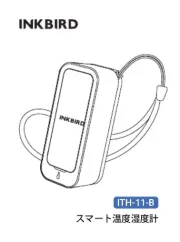
14 Juli 2025
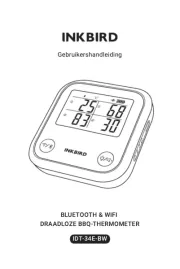
14 Juli 2025
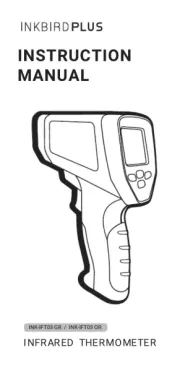
14 Juli 2025
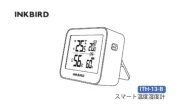
14 Juli 2025